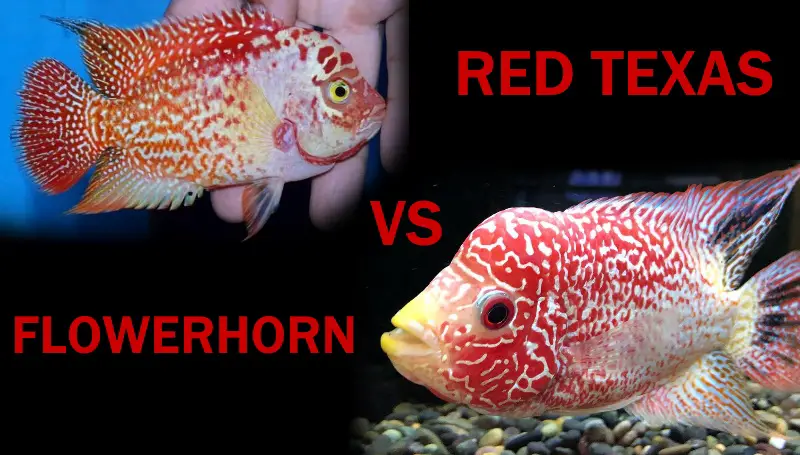Flowerhorns and red Texas cichlids—what’s the difference? Some people think a red Texas cichlid is a type of flowerhorn, and others don’t. So, in this pieice I’m aiming to answer that question along with some others:
- Are red Texas cichlids flowerhorns?
- How do you tell the difference between a flowerhorn and a red Texas?
- Can you cross a flowerhorn and a red Texas cichlid?
Flowerhorns & Red Texas: Species Vs. Hybrids
First and foremost, we have to focus on the fact that both flowerhorns and red Texas cichlids are hybrids. A hybrid is the offspring of two or more different species. This is important because it affects how we define them as living creatures.
What Is A “Species” Anyway?
However, before going too far, let’s pin down what a species is! So, let’s head over to Wikipedia.
“In biology, a species (/ˈspiːʃiːz/ (About this soundlisten)) is the basic unit of classification and a taxonomic rank of an organism, as well as a unit of biodiversity. A species is often defined as the largest group of organisms in which any two individuals of the appropriate sexes or mating types can produce fertile offspring, typically by sexual reproduction. Other ways of defining species include their karyotype, DNA sequence, morphology, behaviour or ecological niche. In addition, paleontologists use the concept of the chronospecies since fossil reproduction cannot be examined.”
You’ll notice after reading that definition that there are several ways to identify a species. It’s helpful to understand these different ways to define “species” when it comes to understanding Central American cichlid hybrids (which is what flowerhorns and red Texas cichlids are).
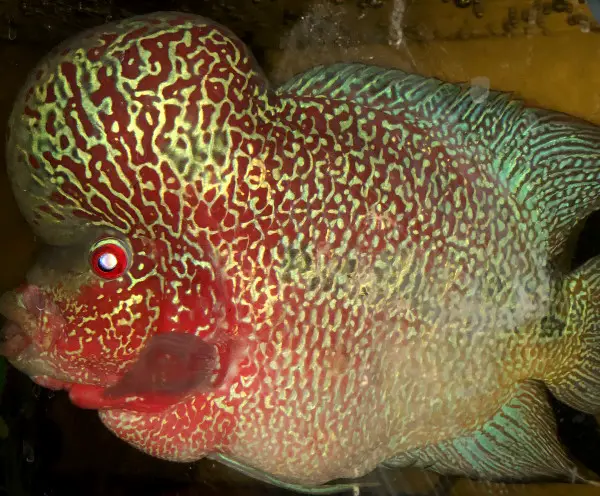
You might be wondering why there are so many definitions. Well, that’s because we—humans that is—are always striving to better understand the world around us. So. to help us understand and communicate our concepts, we use language, and thereby labels, to define things.
However, those labels can be both helpful and restrictive at the same time! “Species” is a great example of that. And that’s why it has multiple definitions, i.e. to give wiggle room.
Let’s break down the first definition: organisms in which any two individuals of the appropriate sexes or mating types can produce fertile offspring. However, grizzly bears and polar bears produce fertile offspring. Yet to the layperson and the biologist alike, grizzly bears and polar bears are clearly a different animal with different a diet, different habits, and a markedly different appearance.
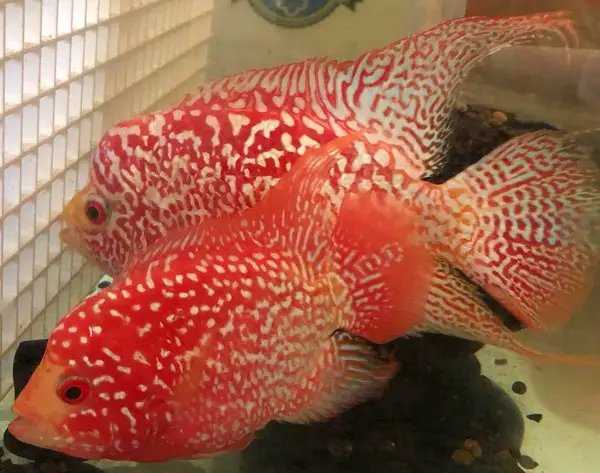
That’s where the other ideas about what a species is become useful. Because in the polar/grizzly bear example, we can use karyotype, DNA sequence, morphology, behavior and the animal’s ecological niche to differentiate them. It’s those other angles we can take to look at animals that allow us the freedom to decide what is a different type (see: species) of animal.
But, above all else, remember that “species” is our concept, not nature’s—so don’t expect the natural world to fall into easily definable species. And so that’s why you might see animals moving from one genus to another, or a subspecies going to a full species after researchers look at the DNA.
Okay, So What’s A “Genus” Then?
When biologists describe a species of plant or animal they use binomial nomenclature to name it. That means they assign a two part name, the first part is the genus and the second part is the species name.
Take us humans for example, our genus is “homo” and our species is “sapiens”. Although, we’re not the best example to explain what a genus is because there are no other living species within the homo genus.
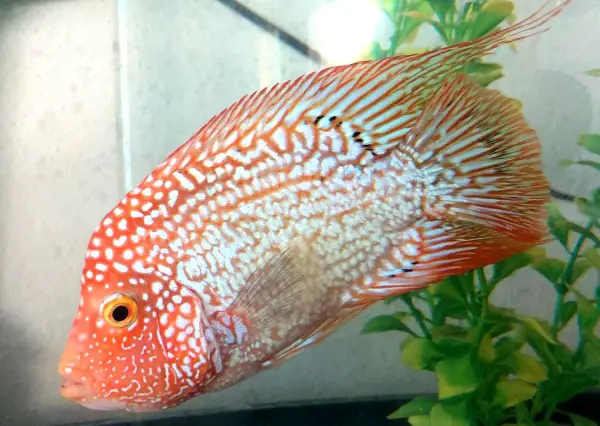
So, instead, let’s use fish! Neon tetras and cardinal tetras look very similar, and that’s because they almost certainly have a recent common ancestor from which they diverged. And that’s the key to a genus, it should point to a close relationship.
Of course, there’s more to it than that, but due to the scope of this article and my own limited understanding, I’ll leave it there!
Flowerhorns & Red Texas: Binomial Nomenclature
As established in the introduction, flowerhorns and red Texas cichlids aren’t a species, they’re hybrids because they’re a mix of more than one species.
So, how does this affect a flowerhorn or a red Texas cichlids scientific name?
Hybrids can be scientifically named by combining their parents’ names with an X in between. For example, a mule is a cross between a donkey (Equus asinus) and a horse (Equuus caballus). Therefore, its scientific name is Equuus asinus x Equuus caballus.

But, as you might already know, the parentage of both flowerhorns and red Texas cichlids often isn’t as transparent as species A + species B = hybrid C. In fact, the differing progenitors of any particular flowerhorn might be unknown and subject to speculation beyond the fact that a trimac cichlid was used at some point in its ancestry.
So, that makes assigning scientific names to flowerhorns challenging.
So What If Flowerhorns & Red Texas Don’t Have A Scientific Name? Who Cares?!
The fishkeeping hobby has definitely benefited from the work of ichthyologists. We can use scientific names to be fairly sure we’re talking about, keeping, buying, or selling the fish we think we are. Are scientists infallible? No, of course not. But, they do publish their findings which are then subjected to peer review.
So, in the absence of biologists to help us name and successfully identify fish, what can we do? Well, we’ll just have to establish our own damn consensus, won’t we? And luckily, I believe hybrid cichlid breeders and keepers have done a decent job of it! By that I mean, most of us interested in the variety agree on what is and isn’t a flowerhorn.
Are Red Texas Cichlids A Type Of Flowerhorn?
And speaking of what isn’t a flowerhorn, a red Texas cichlid is not a flowerhorn.
There’s a tendency to slap the flowerhorn label on any Central American cichlid hybrid with stunning colors. But, that’s not accurate, because there is a critical difference between flowerhorns and red Texas cichlids—a tangible difference at that.
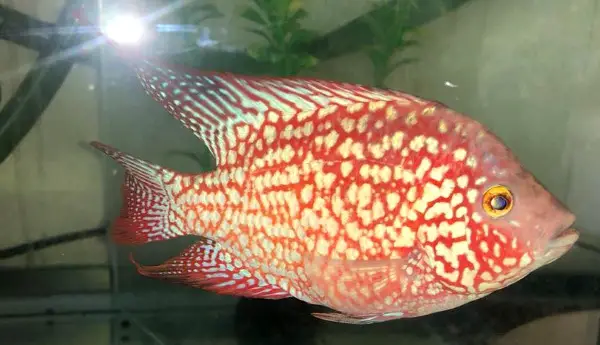
The difference between a flowerhorn and a red Texas cichlid lies in the parents; specifically, the original wild species used as a base. In the case of a flowerhorn, the trimac cichlid (amphilophus trimaculatus) is the original base of the variety. Whereas, with red Texas cichlids, a member of the Herichthys genus (typically H. cyanoguttatus, the Texas cichlid) is used as the base.
How Closely Related Are Flowerhorns & Red Texas Cichlids?
Exactly how closely a flowerhorn and a red Texas cichlid are related really depends on the composition of the flowerhorn in question.
Because, for example, if the flowerhorn is a “golden based fader” then it likely has midas or red devil blood somewhere in its line. Whether that comes directly from a midas or a red devil, or from a hybrid like a red mammon or a blood parrot, doesn’t really matter, because that is where the wild “fading” characteristic comes from. The same goes for the yellow/orange coloration, because it also originates with midas and red devil cichlids.
Furthermore, if a flowerhorn has a prominent “pearling” pattern (i.e. lots of small white spots across its body) then it could very well possess some Herichthys cyanoguttatus blood. As such, a flowerhorn and a red Texas cichlid might be quite closely related in terms of composition. However, they remain distinctly different due to their underlying base species, (i.e. trimac for flowerhorns and Texas cichlid for red Texas cichlids).
How Do You Tell The Difference Between Flowerhorns & Red Texas Cichlids?
To the untrained eye, some types of flowerhorn look very much like a red Texas cichlid because they share reddish coloration along with white pearling. For example, a fireman’s dream flowerhorn is easy to confuse with a red Texas cichlid because they share a similar aesthetic.
However, even in cases where red Texas and flowerhorns look similar, there are key ways in which you can tell them apart.
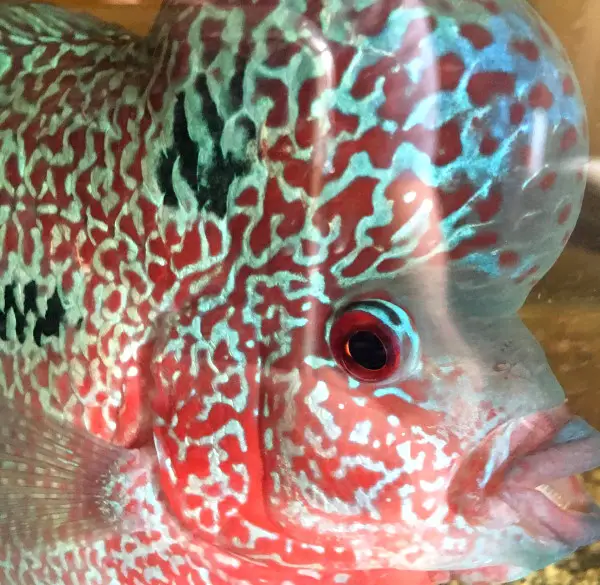
When judging whether a fish is a flowerhorn or a red Texas, first and foremost, you should look at the eyes.
Because the trimac is the base of any flowerhorn, it will have a red eye. Consider that even Thai blue silk flowerhorns—where the entire body is a bluish white—still possess the quintessential flowerhorn red eye. Also, the same goes for golden based faders, super red dragons, etc, the eye is always red.

Whereas, a red Texas cichlid has no trimac blood it will therefore not have a red eye (its eye will typically be yellow or sometimes orangish). Also, the eyes can sometimes be black while the fish in the process of fading. However, once fading completes, it will reveal an underlying yellow eye.
The nuchal hump or “kok” is another good way to tell red Texas cichlids and flowerhorns apart. But, it’s not as reliable as looking at the eyes. This is because, generally, flowerhorns are going to have a much larger nuchal hump than red Texas cichlids. However, the reason it isn’t as reliable as looking at the eyes is because red Texas cichlids can also have a prominent nuchal hump.
The most reliable way to know the difference between a red Texas and a flowerhorn is simply to ask the breeder, because he or she will know the parentage!
Can You Cross A Red Texas & A Flowerhorn?
Yes, it is possible to cross a flowerhorn with a red Texas cichlid. It is quite common for breeders to cross a red Texas cichlids and flowerhorns, but the generally accepted name for them is quite confusing indeed. This is because breeders tend to refer to red Texas cichlids with flowerhorn blood as “red Texas hybrids”. This is confusing because a red Texas cichlid and a flowerhorn are hybrids themselves, so remember if you see a fish that looks like a red Texas but has a red eye and is labeled as a “red Texas hybrid” then be aware that a flowerhorn was used in its creation.
Additional Reading
- How To Breed Red Texas Cichlids
- Flowerhorn vs Oscar: Best Wet Pet
- Grading Red Texas Cichlids
- Difference Between Red And Super Red Texas
Thanks To Instagram User “Colorbeige” For All Pics On This Article
Colorbeige works directly with breeders and trans shippers to get some of the best red Texas cichlids and flowerhorns into the US and then offers them for sale. Contact him if you’re in the US and are looking to purchase some great fish.

